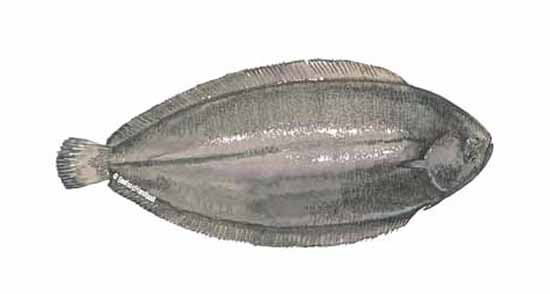Sole, Dover
Published on
January 23, 2014

There are no true soles along America’s eastern shore, though there are several species in European waters. The best of them is the Dover sole, a mainstay of the European seafood scene for generations and considered one of the foundations of Continental cuisine. This thick-bodied flatfish never gets much longer than 20 inches and, like other soles, has its eyes on the right-hand side. Don’t confuse the European Dover sole with America’s West Coast “Dover” sole (Microstomus pacificus). They are not the same fish. The geographical title “Dover” was tacked on to the true sole because the English town of Dover could supply more fish for London’s Billingsgate market than any other fishing village. But, despite its name, Dover sole is caught in other places. This flatfish ranges from the Mediterranean to the North Sea and is usually found in shallow waters. The best grounds are said to be the North Sea and the Bay of Biscay. Dover sole is landed by trawlers.
Solea vulgaris
Sole
European Dover sole, common sole, genuine Dover sole
Sole commune
Seezunge
Sogliola
Shitabirame
Lenguado
There are no true soles along America’s eastern shore, though there are several species in European waters. The best of them is the Dover sole, a mainstay of the European seafood scene for generations and considered one of the foundations of Continental cuisine. This thick-bodied flatfish never gets much longer than 20 inches and, like other soles, has its eyes on the right-hand side. Don’t confuse the European Dover sole with America’s West Coast “Dover” sole (Microstomus pacificus). They are not the same fish. The geographical title “Dover” was tacked on to the true sole because the English town of Dover could supply more fish for London’s Billingsgate market than any other fishing village. But, despite its name, Dover sole is caught in other places. This flatfish ranges from the Mediterranean to the North Sea and is usually found in shallow waters. The best grounds are said to be the North Sea and the Bay of Biscay. Dover sole is landed by trawlers.
Few fish command more respect in culinary circles than the true Dover sole, which yields thin yet firm fillets that hold together well in many preparations. The raw meat is glistening white and dense and cooks up white. The flavor of the Dover sole is mild and sweet.One fan of Dover sole describes the fish as being “more like a meat. It doesn’t have the texture of a normal fish.” Despite its delicate flavor, it’s able to stand up to the heavy sauces favored by European chefs.
| Calories: | 91 |
| Fat Calories: | 16.2 |
| Total Fat: | 1.2 g |
| Saturated Fat: | 0.3 g |
| Cholesterol: | 48 mg |
| Sodium: | 81 mg |
| Protein: | 18.8 g |
| Omega 3: | 0.2 g |
Like all flatfish, Dover sole yields a thin fillet, which makes it prone to over-cooking. As a result, it’s better suited to poaching, steaming or saucing than to dry-heat methods like baking or broiling. When sautéing, slip a slice of raw potato under the thin part of the tail to allow for more even cooking. Dover sole is considered excellent cooked on the bone. In fact, in England, the fish is often served whole and filleted at the table.
Flounder, Other soles
- Bake
- Boil
- Broil
- Fry
- Grill
- Pate
- Poach
- Saute
- Smoke
- Steam
Fresh: Dressed, Fillets
Frozen: Dressed, Fillets
Africa, France, Italy, Netherlands, UK





